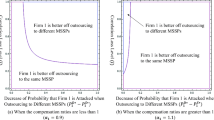Abstract
There has been damage to users due to security problems such as personal information leaks and spam etc. by IT convergence in various information communication industries. Since where the responsibility for this damage lies, compensation systems and damage estimation criteria have not been prepared yet, its compensation is solved by civil litigation between service providers and users. In addition, for security services provided, the standardized clauses of a contract with consumers are provider-oriented articles to be disadvantageous to service users, and detailed compensation criteria have not been prepared in reality. Therefore, it is time to need to prepare a damage compensation system and an estimation criterion for protecting users against technical and legal troubles that could arise when providing security services.
In order to solve these problems, this paper developed a damage compensation index for sustainable security service. In detail, by analyzing damage compensation criteria and cases for general information communication services, a damage compensation index on security services was developed for a goal of VoIP services. It could offer voluntary improvement of service quality for service providers, and simplicity of damage compensation for users. Additionally, it could socially give benefits of increasing the number of companies to apply the security SLA and mitigating legal disputes.




Similar content being viewed by others
References
Stubblefield, A., Rubin, A. D., & Wallach, D. S. (2005). Managing the performance impact of web security. Electronic Commerce Research, 5(1), 99–116.
Ganna, F. (2007). Service level agreements: web services and security. In Proceedings of the 7th international conference on web engineering (pp. 556–562).
Frankova, G. (2007). Service level agreements: web services and security. In Proc. of the 7th international conference on web engineering (Vol. 4607, pp. 556–562).
Chang, H., Kwon, H., Kang, J., & Kim, Y. (2008). A case study on intelligent service design in ubiquitous computing. Computing and Informatics, 30(3), 513–529.
Scarle, S., Arnab, S., Dunwell, I., Petridis, P., Protopsaltis, A., & de Freitas, S. (2012). E-commerce transactions in a virtual environment: virtual transactions. Electronic Commerce Research, 12(3), 379–407.
Röhrig, S., & Knorr, K. (2004). Security analysis of electronic business processes. Electronic Commerce Research, 4(1–2), 59–81.
Verkaik, P., Agarwal, Y., Gupta, R., & Snoeren, A. C. (2009). Softspeak: making VoIP play well in existing 802.11 deployments. In Proceedings of the 6th USENIX symposium on networked systems design and implementation (pp. 409–422).
Franke Kleist, V. (2004). A transaction cost model of electronic trust: transactional return, incentives for network security and optimal risk in the digital economy. Electronic Commerce Research, 4(1–2), 41–57.
Mazurczyk, W., & Kotulski, Z. (2008). In Covert channel for improving VoIP security, advances in information processing and protection, part II (pp. 271–280).
Liu, X., & Tu, C. (2011). Research on security of VoIP network. Communications in Computer and Information Science, 231, 59–65.
Kim, Y., Kang, J., Na, Y., & Chang, H. (2012) In Lecture notes in electrical engineering: Vol. 164. Study on development of appraisal business performance indicator (pp. 417–423).
Acknowledgements
This research was supported by a 2013 Research Grant from Sangmyung University.
Author information
Authors and Affiliations
Corresponding author
Rights and permissions
About this article
Cite this article
Chang, H. The security service rating design for IT convergence services. Electron Commer Res 13, 317–328 (2013). https://doi.org/10.1007/s10660-013-9115-2
Published:
Issue Date:
DOI: https://doi.org/10.1007/s10660-013-9115-2




